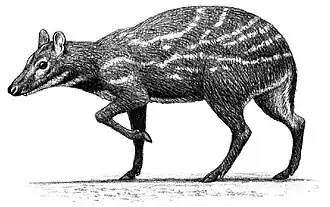Dorcatherium
| Dorcatherium | |
|---|---|
| Dorcatherium naui skeleton, Staatliches Museum für Naturkunde Stuttgart | |
| Scientific classification | |
| Kingdom: | Animalia |
| Phylum: | Chordata |
| Class: | Mammalia |
| Order: | Artiodactyla |
| Suborder: | Ruminantia |
| Infraorder: | Tragulina |
| Family: | Tragulidae |
| Genus: | † Johann Jakob Kaup, 1833 |
| Type species | |
| †Dorcatherium naui Kaup & Scholl, 1834
| |
| Other species | |
| |
Dorcatherium is an extinct genus of tragulid ruminant which existed in Europe, East Africa, and the Siwaliks during the Miocene and possibly Pliocene.[1]
-
 Dorcatherium sp. by Mauricio Anton
Dorcatherium sp. by Mauricio Anton -
Dorcatherium minus jaw fragments, Natural History Museum, London
-
_Dorcatherium_crassum_-_H%C3%A9mimandibule_gauche.jpg) Dorcatherium crassum Left Hemi Mandible MHNT
Dorcatherium crassum Left Hemi Mandible MHNT -
_Dorcatherium_guntianum_-_H%C3%A9mimandibule_gauche.jpg) Dorcatherium guntianum Left Hemi Mandible MHNT
Dorcatherium guntianum Left Hemi Mandible MHNT
Palaeoecology
D. naui was partially frugivorous, the evidence for this being its dental enamel's 87Sr/86Sr, δ18OCO3, and δ13C values.[2] The dental microwear and mesowear of D. naui provides further evidence that it was a frugivorous browser.[3] At the Middle Miocene site of Maboko in Kenya, D. pigotti displays relatively high δ13C values, probably indicative of feeding in less wooded environments than modern tragulids, while the δ13C values of D. chappuisi at the same site were even higher, suggesting a preference for even more open and arid habitats than D. pigotti.[4]
References
- ^ McKenna, M. C.; Bell, S. K. (1997). Classification of Mammals: Above the Species Level. Columbia University Press. p. 631. ISBN 978-0-231-11013-6.
- ^ Aiglstorfer, Manuela; Bocherens, Hervé; Böhme, Madelaine (18 February 2014). "Large mammal ecology in the late Middle Miocene Gratkorn locality (Austria)". Palaeobiodiversity and Palaeoenvironments. 94 (1): 189–213. doi:10.1007/s12549-013-0145-5. ISSN 1867-1594. Retrieved 27 November 2024 – via Springer Nature Link.
- ^ Merceron, Gildas (July 2009). "The early Vallesian vertebrates of Atzelsdorf (Late Miocene, Austria) 13. Dental wear patterns of herbivorous ungulates as ecological indicators" (PDF). Annalen des Naturhistorischen Museums in Wien. 111A: 647–660. Retrieved 13 August 2025.
- ^ Arney, Irisa; Benefit, Brenda R.; McCrossin, Monte L.; MacLatchy, Laura; Kingston, John D. (1 September 2022). "Herbivore isotopic dietary ecology of the middle Miocene Maboko Formation, Kenya". Palaeogeography, Palaeoclimatology, Palaeoecology. 601: 111061. doi:10.1016/j.palaeo.2022.111061. Retrieved 16 February 2025 – via Elsevier Science Direct.